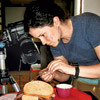 |
The centerpiece of Bryan Smith‘s research for Witness at Haditha was an interview with Sgt. Sanick Dela Cruz, who initially was reluctant to talk. "As the lone marine willing to testify against his fellows in the now-infamous Haditha killings, he had every reason not to want to relive the horrors of the experience—and potentially open himself up to more scorn from his brothers," Smith says. Eventually, Smith flew to California to talk to the marine. "After he told me his story—the first time he has recounted what he saw and did that day—I could understand his deep reluctance," Smith says. Making the interview even more difficult for Dela Cruz was the fact that one of the men now awaiting court-martial, Sgt. Frank Wuterich, is also the fellow marine Dela Cruz names as his best friend in Kilo Company. Smith doesn’t mince words in describing Dela Cruz’s story: "His version of events that day is raw, shocking, and horrible." Smith is writer-at-large for Chicago.
 |
Tyllie Barbosa, who has photographed food for Chicago since 2002, keeps her pictures natural. This means her food stylist, Christina Zerkis (left; a former Moto kitchen worker), prepares and plates the food in Barbosa’s studio. Then comes the shooting, sometimes in a flurry. "You have to move pretty quick," Barbosa says. "Especially [with] meat and fish: It oxidizes." Afterwards the photo staff finishes the food off—if they have an appetite, then readers who see the photo probably will, too. "That’s always my thing: Make people say, ‘Oh, my God, I’m so hungry,’ " Barbosa says. Her work has appeared in Gourmet, Cooking Light, and Vogue.
 |
"I think of myself first and foremost as a journalist," says Dan Winters, who photographed Sgt. Sanick Dela Cruz for Witness at Haditha. He believes the photographer’s role is to augment the writer’s work. "It’s nice to do something that’s kind of linear with the story rather than regurgitate it," he says. With Dela Cruz, Winters looked to capture his psychological profile: "Looking into his eyes—what his eyes have seen," Winters says. His book Virtue and Vice is scheduled to be published by Aperture next spring. His work has appeared in The New York Times Magazine, Texas Monthly, Rolling Stone, GQ, Esquire, and The New Yorker.
In "War Games" in Arena this month, Andrew Schroedter interviews Wafaa Bilal, an Iraqi-born artist who is showing a controversial video-game piece at Flatfile Galleries, on the West Side. Schroedter, a freelance writer, took note when the previous installation of Bilal’s exhibition was shuttered after one day. "How many artists today get censored?" Schroedter asks. A political refugee since 1992, Bilal learned to paint with free art supplies from Saddam Hussein’s youth centers. "If you really understand what he’s saying, it isn’t as shocking as you might think," Schroedter says. He has written for the Tribune, the Sun-Times, and the Daily Herald, and he was a key contributor to Who Makes What, the salary survey that appeared in Chicago‘s April issue.
 |
In 14 years at Stroger Cook County Hospital, Brendan Reilly has encountered many patients with remarkable stories. Some of them he writes up for medical journals. With the story of Jesus Trujillo, in this month’s Reporter column, Reilly decided to write it for a general audience at the suggestion of his son, the Chicago alderman of the same name. The head of medicine at County, Reilly says asking questions about the patient’s history is a key part of treatment, both to offer better care and to practice good bedside manner. "It’s a great profession," he says. "You literally are allowed into other people’s lives in a way that very few other people are. It’s a privilege, but it’s also very private."
Not exactly a lounge lizard in her normal life, Miriam Gottfried sampled around 15 restaurant/lounge crossbreeds for her article "Power Bars" in this month’s Table. The research let her sample innovative cocktails, and she may be a convert. "One of my friends started making the Manhattan from The Violethour. Now we’re really into drinking those," she says. But she draws the line at "fauxtinis"—ginless, vermouthless, inaccurately named mixed drinks served in a martini glass. "It’s a trend that’s run amuck," she says. In addition to her work as a dining critic for Chicago, Gottfried freelances for Crain’s Chicago Business and Chicago Public Radio and blogs at TheMangoLassie.com.
Photography: (Smith) Joe C. Moreno, (Zerkis) Melissa Romito, (Winters) Jeff Wilson, (Reilly) Joe C. Moreno



